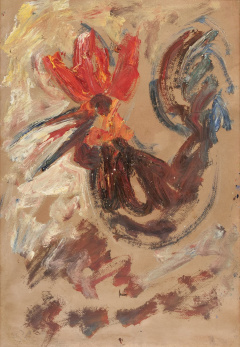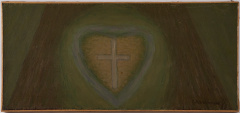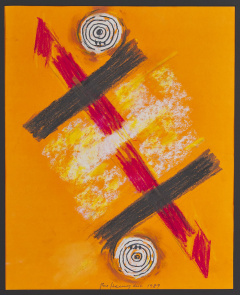The first world war in the schedule of Russian and German artists from the Hermitage
In the field Marshal's hall of the Winter Palace, the exhibition-событие "the First world war in the schedule of Russian and German artists in the Hermitage", which features over twenty graphic works: posters, illustrations and popular prints. The exhibition is timed to the centenary of the outbreak of the First world voyny@
August @ & mdash; October, 1914, the Moscow publishing house "Today's lubok" printed colour on military topics. This is a traditional art of printmaking addressed to the broad masses. In the most accessible and simplest form it told of agitated people events. In Moscow artists-футуристы K. Malevich, D. Burliuk, , A. Lentulov, V. Chekrygin strove to revive this art. In a crude manner and common language, they ridiculed the enemy, anticipating a swift and inevitable victory. Lubok an important and necessary element is the text accompanying the image. All the poetry texts for prints and postcards were written by Mayakovsky. It is known that he himself made the images of at least six pages, two of which are shown on vistavka@
the futurist woodcuts typical bright image system, combining motives of current events with coarse, graphic language, stylized, as in poetry, for folksy art. This form was common for the entire series, which puts modern researchers of the Russian avant-garde at a standstill as many works do not have a confirmed autorstwa@
In those days, and attempt to create something similar is being done by the futurists and in Petrograd, where anonymous publishing house "W. F. T." printed four color lithography. A large portion of these works of art were shown at the exhibition "War and print," which opened in Petrograd on November 20, 1914. Great walking these prints have not received, and the descendants appreciated the work of the futurists is significantly higher than Sovremennik@
To the same great masses of people were intended to appeal posters for the war loan 1916. The sources of external loans for the second year of the war were scanty, and it was decided to address the nation. In an accessible and vivid form posters and postcards appealed to the Patriotic feelings (Saint George, monument to Minin and Pozharsky), recalled the difficult conditions of fighting on the front (the soldiers in the snow at the guns), about the needs of the front ("slug hunger"). The posters were made by artists in various styles, but perhaps the common is the impact of the graphic school "World of art" for the most part approved for printing compositions. In this project, several artists participated, V. Barganski,, Jankowski, V. Vereshchagin, which are now forgotten. In the Hermitage paintings in which colour posters were printed loans were made after the revolution. Like all the exhibits, they are shown vpervye@
After world war II in the Hermitage received from Germany a large group of pictures of German frontline artists made in 1914-1918. They were previously in the collection of the Zeughaus Museum of German military history, Berline@
, One of them — this is a gouache painter of the German General staff, Ernst Folber. Once famous in Germany, he is now thoroughly forgotten at home, and outside of Germany is completely unknown. From 1914-1918 he was a war artist on the Western front. The most popular use of the panorama of his brush (including air).
the Hermitage has 817 works of Folber. It's different in the story of the works: sketches of the front line occupied lands, ruins, scenes from daily life in the trenches of the front and the rear, hospitals, airports, scenes of fighting, the wounded and the dead, portraits of soldiers, officers, chief command, etc. these things are high professional level features a meticulous documentary precision. Gouaches are grouped into thematic portfolios and numbered according to Chronologie@
On many Folber's pages at the back have the stamp "Kriegsgeschichtlich richtig" ("From a military point of view and historically correct") and the signature of a certain General-лейтенанта. This phrase precisely determines the value of the artist's art. It is not propaganda, it is recording events. And this makes it more reliable and expressive than let the picture of those let@
These same words can be said about the 925 works Otto Engelhardt-Кифхойзера, an artist less famous than Folberg. The artist was born in Saxe-Ангальте in 1884. In 1901-1907, he studied at the Academies of fine arts in Kassel, Berlin and Weimar. In 1914, twenty years old, he was drafted and fought in the rank of Feldwebel Jaeger battalion on the Western and Eastern fronts. Right in the trenches he was doing in a notebook a pencil and pen sketches of the fighting, the front line, the various moments of a soldier's life, portraits of fellow soldiers, local residents, prisoners and more. These are pencil, watercolor and gouache. They usually have the exact date (and sometimes time) and an inscription explaining the events, the names, the place of action. Their value — in the absolute documentation. They have not been adjusted in the workshop. Here each image dostoverno@
Graphics Folber and Engelhardt-Кифхойзера — this is a very specific material. It is still difficult to include in the long-established Canon of European art. The tragic history of the twentieth century, and these sad Chronicles of the both masters have their place. Their dignity in the accuracy of transmission events of their direct participants. Their art speaks about the people of that time no less than the numerous works of later historians. It makes sense today to look at them more vnimatelno@
Curator — Mikhail Olegovich Dedinkin, Deputy head of the Department of Western European art of the State Hermitage@
Source: hermitagemuseum.org
Permanent link to:
https://artinvestment.ru/en/news/exhibitions/20140814_1ww_hermitage.html
https://artinvestment.ru/news/exhibitions/20140814_1ww_hermitage.html
© artinvestment.ru, 2024
Attention! All materials of the site and database of auction results ARTinvestment.RU, including illustrated reference information about the works sold at auctions, are intended for use exclusively for informational, scientific, educational and cultural purposes in accordance with Art. 1274 of the Civil Code. Use for commercial purposes or in violation of the rules established by the Civil Code of the Russian Federation is not allowed. ARTinvestment.RU is not responsible for the content of materials submitted by third parties. In case of violation of the rights of third parties, the site administration reserves the right to remove them from the site and from the database on the basis of an application from an authorized body.









